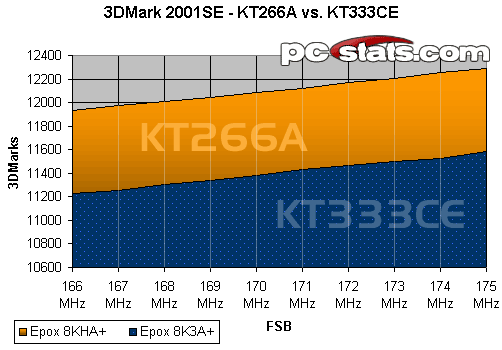VIA's KT333CE Chipset 3D Performance Stumbles at 166MHz FSB
The 3D performance of the KT333CE Vs. KT266A is
not so clear cut at higher bus speeds, is something awry?
 |
|
At higher 166MHz FSB speeds or higher the KT333CE based motherboards we tested illustrated a
lower set of 3D performance scores than similarly equipped motherboards
running the KT266A chipset. In this case, the older Epox 8KHA+ outperforms
the Epox 8K3A+ at Front Side Bus speeds of between 166MHz and 175MHz by
just over 700 points on average. This is mostly caused by the 1/2.5 AGP
divider present in all KT333CE boards. The AGP at 166 MHz with the KT333CE
is running at stock speeds (66 MHz) while with the KT266A it's running at
88 MHz. |
Since the introduction of the KT333CE chipset there have been some strange benchmarking results cropping
up which are hard to explain. In a broad number of 3D
oriented benchmarks, at higher bus speeds, VIA's KT333CE chipset seems to
be performing consistently slower than the older VIA
KT266A chipset.
After a few late nights discussing this with VIA
directly, we have come to believe that these peculiarities are due to the
introduction of the 2/5th AGP divider.
According to VIA the only differences between
the KT266A and KT333CE chipsets is the addition of an asyncronous memory
controller which supports JEDEC DDR333 SDRAM, and the 1/5th PCI
and 2/5th AGP dividers.
With the Front Side Bus running at overclocked
speeds of 166MHz, the KT266A chipset has the AGP working at 88MHz. Under the
same conditions the KT333CE chipset clocks in at just 66MHz.
Because of the new 2/5th
AGP divider the VIA KT333CE chipset is able to run the AGP bus at stock speeds of
66MHz even when the Front Side Bus is overclocked. Therefore, with the
Front Side Bus of the KT333CE chipset at either 133MHz or 166MHz, the AGP
bus remains at a stock speed of just 66MHz.
In regards
to what we have been noticing with certain benchmarks (at overclocking speeds of
166FSB or higher) is that while overall performance good, 3D
performance and memory bandwidth are not higher than KT266A levels.
Of course, at stock speeds VIA's KT333CE chipset performs better than the KT266A in both
overall system performance and 3D performance. It is only at those overclocked speeds where
things really start go backwards...
A bit of background on what
let up to this discovery:
It all started with the Shuttle AK35 GTR
Ver 2.2 KT333CE which was the first
KT333CE motherboard we tested which would overclock past 166MHz FSB. At 172MHz FSB the 3D performance in
benchmarks like Madonions' 3DMark2001SE was noticeably lower then expected, and this was noted in the Shuttle review on page
3. In that review the Shuttle motherboard was
benchmarked at 165MHz FSB because it
offered better results than at the highest possible FSB setting of 172MHz. Thinking this might have been a BIOS issue
with the unit we tested, we didn't explore the odd results any further... at least for a while.
The next KT333CE motherboard in line for
review was the 8K3A+ from Epox. Remembering the
great performance of the original 8KHA+, we expected the 8K3A+ to be even better
with DDR333 support.
After about
a week of tweaking and tuning the 8K3A+ till we could tweak no
more we finally accepted the fact that we just couldn't reproduce
those "excellent" numbers. Now it's not as though the Epox 8K3A+ didn't
overclock well - it is the best motherboard for overclocking we've ever used -
it's just that the 3D performance at 200 MHz+ FSB's was quite a bit
lower
then it seemed it ought to be.
In fact it
was at 200MHz FSB (with the most aggressive memory timings) that
we came across some really curious results; the memory bandwidth
was off, and overall system performance was comparatively low to
the KT266A version also on the test bench at the time.
We believe
the performance irregularities can be traced to the existance of the 1/2.5
AGP and 1/5 PCI (Mode 5) dividers in the KT333CE. Since these dividers kick in
at 166 MHz FSB it means that the AGP and PCI's are running in
spec (66 MHz for the AGP and 33 MHz for the PCI) while with the KT266A the
AGP and PCI's would be running 88 MHz and 44 MHz respectively. It works this way because
quite obviously those dividers aren't present in the VIA KT266A chipset. Since the
KT266A chipset has a higher AGP and PCI bus, it means that data should move
a lot quicker along the AGP and PCI bus since they're both running at a higher
frequency.

